Puerto Madero
Puerto Madero, also known within the urban planning community as the Puerto Madero Waterfront, is a barrio (district) of the Argentine capital at Buenos Aires CBD, occupying a significant portion of the Río de la Plata riverbank and representing the latest architectural trends in the city of Buenos Aires.
Puerto Madero | |
|---|---|
.png.webp) Puerto Madero skyline | |
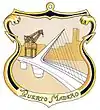 Emblem[1] | |
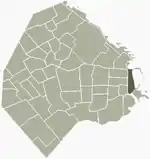 Location of Puerto Madero within Buenos Aires | |
| Country | Argentina |
| Autonomous City | Buenos Aires |
| Comuna | C1 |
| Area | |
| • Total | 2.1 km2 (0.8 sq mi) |
| Population (2010) | |
| • Total | 6,629 |
| • Density | 3,200/km2 (8,200/sq mi) |
| Time zone | UTC-3 (ART) |
History
19th century
.jpg.webp)
From its inception, the city of Buenos Aires had a problem accommodating large cargo ships, as per Puerto La Boca, because the shallow river did not allow for direct docking. Instead ships were moored away from the shore and passengers and merchandise were unloaded onto barges and ferries for transport to the pier.
In 1882 the national government contracted the local businessman Eduardo Madero to take charge of the construction of a new port which would solve these problems. Construction began in 1887 and was completed in 1897, although the installed fittings had been partially operative some years before completion of the port. It was a costly project and an engineering landmark at the time but ten years after its completion the appearance of larger cargo ships made Puerto Madero obsolete.
The government had to then face the construction of a new port, this time contracting engineer Luis Huergo, whose plans for a port of staggered docks which would open directly onto the river was among those rejected in the 1880s. His plans resulted in the "Puerto Nuevo" (New Port), still operating today, whose first section opened in 1911.
 Edward Taylor's pier, a city landmark from 1855 until the docks' development
Edward Taylor's pier, a city landmark from 1855 until the docks' development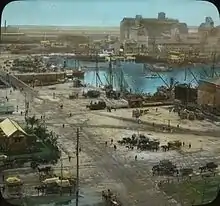 The Buenos Aires Harbor around 1915
The Buenos Aires Harbor around 1915.jpg.webp) Partial view of Buenos Aires Harbor
Partial view of Buenos Aires Harbor Central Train Station is now part of Puerto Madero
Central Train Station is now part of Puerto Madero
20th century: from neglect to recovery
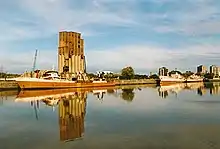
The New Port of Buenos Aires was completed in 1926, making the existing Madero docks superfluous. Though these continued to serve in ancillary port functions, the zone gradually decayed, becoming one of the city's most degraded areas, a mixture of warehouses and large tracts of undeveloped land. In 1925, 1940, 1960, 1969, 1971, 1981 and 1985, successive proposals were put forth with the intent of urbanizing the old port, or to demolish it outright; none of these plans came to fruition, however.
On November 15, 1989, the Ministry of Works and Public Services, the Department of the Interior and the City of Buenos Aires signed the acts of incorporation of a joint-stock company denominated "Corporación Antiguo Puerto Madero" ("Old Puerto Madero Corporation"). Having as objective the urbanization of the area, the federal and city governments participated as egalitarian partners.
The 170 hectares of the place had overlapping jurisdictions: the General Administration of Ports, Argentine railroads and the "Junta Nacional de Granos" (National Grain Board) had interests in the zone. The signed agreement implied the transference of the totality of the area to the Old Puerto Madero Corporation S.A., whereas the government of the city remained in charge of the urban development regulations.
21st century

In the 1990s, local and foreign investment led to a massive regeneration effort, recycling and refurbishing the west side warehouses into elegant houses, offices, lofts, private universities, luxurious hotels and restaurants that conform to a gallery of options for this new district in a city that grew up turning its back to the river. Led by the 1999 opening of the Hilton Buenos Aires, luxurious hotels, state-of-the-art multiplex cinemas, theatres, cultural centres, and office and corporate buildings are located mostly in the east side.
Puerto Madero has been redeveloped with international flair, drawing interest from businessmen, architects and designers such as Santiago Calatrava, Norman Foster, César Pelli, Alan Faena, Philippe Starck among others. Today one of the trendiest boroughs in Buenos Aires, it has become the preferred address for growing numbers of young professionals and retirees, alike. Increasing property prices have also generated interest in the area as a destination for foreign buyers, particularly those in the market for premium investment properties.
The neighborhood's road network has been entirely rebuilt, especially in the east side. The layout of the east side consists currently of three wide boulevards running east–west crossed by the east side's main street, Juana Manso Avenue. The layout is completed with some other avenues and minor streets, running both east–west and north–south, and by several pedestrianised streets.
Every street in Puerto Madero is named after women. The Puente de la Mujer (Women's Bridge), by Spanish architect Santiago Calatrava, is the newest link between the east and west docks of Puerto Madero; a museum inaugurated in 2008, the Fortabat Art Collection, itself resulted from an initiative by Amalia Lacroze de Fortabat (the wealthiest woman in Argentina).
Puerto Madero currently represents the largest urban renewal project in the city of Buenos Aires. Having undergone an impressive revival in merely a decade, it is one of the most successful recent waterfront renewal projects in the world.[2]
At Puerto Madero Dock 2 (between Azucena Villaflor and Rosario Vera Peñaloza - teacher and La Rioja educator) buildings belonging to the Universidad Católica Argentina stand successively to the west, and the Faena Hotel Buenos Aires (formerly Faena Hotel+Universe) is located to the east of Dock 2. Located on the corner of Aimé Painé (Mapuche Princess and indigenous rights activist) and Rosario Vera Peñaloza, the modern Iglesia Nuestra Señora de la Esperanza was inaugurated in 1996 and is dedicated to the Virgin Mary, who under the title of Stella Maris, or "Star of the Sea", is the patron saint of the Argentine Coast Guard. The docks aligned with Dique 2, between 1400 and 1500 of Avenida Moreau de Justo, are mostly occupied by various apartment buildings and offices of the Universidad Católica Argentina and its Pabellón de las Artes (Arts Pavilion), a space for art showings with access from the pedestrian side of the dock. Here, there are some bars and coffee shops.


New high-rise construction
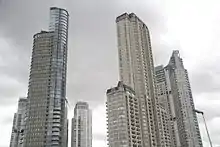


Numerous new residential high-rises of up to 50 stories have been built facing the Rio de la Plata since 2000. These include Alvear Tower, Renoir Towers, El Faro Towers, Chateau Tower of Puerto Madero and Mulieris Towers amongst others. Many other high-rises that have recently been inaugurated include the Le Parc Tower and Hilton and River View Towers. Office and hotel high-rises are also being built such as the Repsol YPF Headquarters and the Conrad Buenos Aires Hotel & Resort, whose construction is slated to begin at the end of 2008 and completion scheduled for late 2010.[3]
Additionally a St. Regis Starwood Hotel is being built in the first dique, where the famous nightclub Opera Bay was formerly located, and is scheduled to open in 2013. A large Jumeirah Polo resort will also feature a hotel in Puerto Madero, working conjointly with polo fields outside Buenos Aires.
Transportation
The 2 kilometres (1.2 mi) Tranvía del Este, inaugurated in 2007 and closed in 2012, served the area running parallel to Alicia Moreau de Justo Avenue, along the barrio's western side. The neighborhood is still not well-connected to the city's transit network. Few bus routes run through Puerto Madero, no subway line reaches it and there are currently no official plans to extend the subway network to the neighborhood despite planned further extensions of the tramway slated to link the Retiro and Constitución train stations.[4]
Expressway controversy
An expressway connecting the north and the south of the city through Puerto Madero has long been in the planning stage. Several alternatives have been considered, including elevated, groundlevel, underground, and even an underwater proposal by private developer Julio Torcello, which would have run under the four docks. This last proposal was dismissed as impossible to build.[5][6] All proposals have been criticised: the elevated and ground level options because they would constitute a barrier between Puerto Madero and the rest of the city, and the underground scheme because of the cost and the negative impact during construction. Placing the expressway between Puerto Madero and the Buenos Aires Ecological Reserve has also been considered, but has been strongly opposed by environmentalists.
Museums and Art Galleries
In the neighborhood there are several museums and art galleries, among them Fortabat Art Collection, Faena Arts Center, De la Cárcova Museum.
The list includes:
Visual index to buildings, monuments, and attractions
 Puerto Madero from Buenos Aires Ecological Reserve
Puerto Madero from Buenos Aires Ecological Reserve Hilton Hotel and River View Towers behind the Yacht Club
Hilton Hotel and River View Towers behind the Yacht Club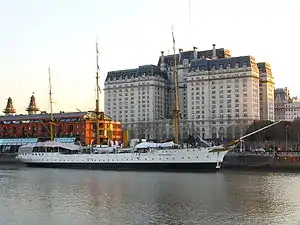 Libertador Building, the Argentine Ministry of Defense
Libertador Building, the Argentine Ministry of Defense.jpg.webp)
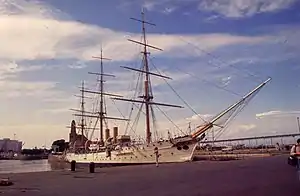
.jpg.webp)
 Eduardo Pla's "The Sphere Dream."
Eduardo Pla's "The Sphere Dream."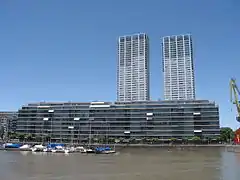

References
- "The emblems of the 48 barrios of Buenos Aires were presented" (Spanish) by ámbito.com August 29, 2011
- Ann Breen and Dick Rigby, The New Waterfront: A Worldwide Urban Success Story – McGraw-Hill Professional
- Conrad Buenos Aires to debut in popular Puerto Madero area
- Rossi, Antonio (2007). "Proyectan Tranvía de Retiro a Constitución". La Nación (in Spanish). Retrieved 2007-07-13.
- Baccaro, Diana / Brunstein, Carolina (1999). "Polémica por la futura autopista ribereña". Clarín (in Spanish). Retrieved 2008-01-08.CS1 maint: multiple names: authors list (link)
- "Estudian hacer una autopista subterránea en Puerto Madero". Clarín (in Spanish). 1997. Retrieved 2008-01-08.
Bibliography
- Ann Breen and Dick Rigby, The New Waterfront: A Worldwide Urban Success Story – Text: English, McGraw-Hill Professional; 1 edition (1996) - ISBN 0-07-007454-2 - ISBN 978-0-07-007454-5
- Jorge Francisco Liernur, Harvard University Graduate School of Design, CASE, Nº6: Puerto Madero Waterfront – Text: English – Prestel Publishing (2007) - ISBN 3-7913-3517-0 - ISBN 978-3-7913-3517-9
- Waterfronts - A new frontier for cities on water Text: English, Edizioni Città d'Acqua, Venezia
External links
 Media related to Puerto Madero, Buenos Aires at Wikimedia Commons
Media related to Puerto Madero, Buenos Aires at Wikimedia Commons- Official Puerto Madero website
- Unofficial Puerto Madero tourist and entertainment guide (Spanish)
- www.youtube.com Puerto Madero video
- Unofficial Puerto Madero guide with pictures and sightseeings (English)
- Photographic documentation and panoramas